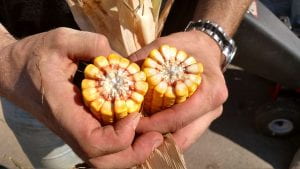
CCE Delaware teamed up again with Dairy One, and their portable NIR, to test corn dry matter (DM) and starch content this week and the results are in the chart below.
The 48 samples of corn tested on September 16th averaged 32% DM with a range of 26% DM to 39% DM. Starch content averaged 31% with a range between 25% and 38%. Interestingly, these results are nearly identical to the averages we got on the 29 samples we tested on September 7th. This does not mean that corn has not progressed in maturity, but is likely a function of the heavy rain we received on Wednesday of this week, and a greater number of samples of later planted corn sampled this week. Some fields that were tested on both dates were 2-3 points drier this time than on Sept 7th, still wetter than we would have expected though.
On the average our samples would be at an ideal DM in the next 7 days. Samples at 30% DM on the 16th would be reaching the harvest window September 22nd to 30th. This could change with warmer/cooler weather, frost, advanced leaf disease damage etc.
Maturity varied from ¾ milk line to ears still in milk stage, but ear stage alone was not adequate to guess dry matter (DM) content. DM is the best way to decide on harvest readiness, because it best predicts fermentation quality. We recommend 32 – 36% DM for bunk silos and bags, 35 – 38% DM for upright silos. Remember proper length of cut, thorough kernel processing, and adequate packing are all critical in making quality corn silage.
As corn matures it will increase in starch content, and increase in yield. Harvesting too early (<32% DM) will result in reduced yield, reduced silage starch content, challenged fermentation and increased risk for silo juicing (which is a potent pollutant as well as tough on silos). Harvesting too late (>40% DM) will lead to poor fermentation and lower starch digestibility. Continuing to monitor whole plant DM is critical. Getting DM into the target zone yields best fermentation. Use of reputable inoculants helps on corn silage, especially when it is getting dry. Inoculants containing Lactobacillus Buchneri have been shown to be more effective with corn silage. Increasing chop length with wetter silage may also reduce silo juicing.
| Town | Ear Maturity (milk line) | DM % | Starch % |
| Andes | 1/4 | 33 | 31 |
| Andes | 1/4 | 32 | 31 |
| Andes | Early Dent | 32 | 29 |
| Davenport | milk | 30 | 28 |
| Davenport | Early Dent | 27 | 27 |
| Delhi | 1/2 | 32 | 31 |
| Delhi | Early Dent | 31 | 28 |
| Delhi | Early Dent | 32 | 32 |
| Delhi | 1/3 | 34 | 32 |
| Delhi | 2/3 | 35 | 34 |
| Hamden | 1/4 | 30 | 29 |
| Hartwick | 1/4 | 31 | 31 |
| Jefferson | milk | 28 | 26 |
| Jordanville | 1/3 | 27 | 30 |
| Jordanville | Early Dent | 31 | 31 |
| Kortright | 1/2 | 39 | 37 |
| Kortright | 1/2 | 36 | 35 |
| Kortright | 3/4 | 37 | 36 |
| Kortright | 3/4 | 38 | 38 |
| Kortright | Early Dent | 29 | 27 |
| Kortright | 3/4 | 36 | 34 |
| Kortright | 1/3 | 32 | 31 |
| Kortright | 1/3 | 31 | 31 |
| Kortright | 2/3 | 32 | 32 |
| Kortright | 1/3 | 31 | 31 |
| Kortright | 1/3 | 30 | 31 |
| Kortright | 1/2 | 31 | 31 |
| Meredith | Early Dent | 27 | 27 |
| Middletown | 1/3 | 34 | 30 |
| Middletown | 1/4 | 33 | 29 |
| Middletown | 1/4 | 33 | 29 |
| Middletown | Early Dent | 36 | 32 |
| Prattsville | 1/2 | 37 | 33 |
| Prattsville | 1/2 | 32 | 29 |
| Prattsville | 1/2 | 32 | 30 |
| Roxbury | milk | 29 | 26 |
| Roxbury | 1/4 | 31 | 31 |
| Roxbury | 1/2 | 30 | 31 |
| Stamford | 1/2 | 37 | 37 |
| Stamford | 2/3 | 36 | 33 |
| Stamford | Early Dent | 30 | 28 |
| Stamford | Early Dent | 30 | 29 |
| Stamford | 1/2 | 35 | 36 |
| Stamford | 3/4 | 35 | 34 |
| Walton | 1/2 | 33 | 34 |
| Walton | milk | 26 | 26 |
| Walton | milk | 26 | 25 |
| Windham | 2/3 | 31 | 32 |

